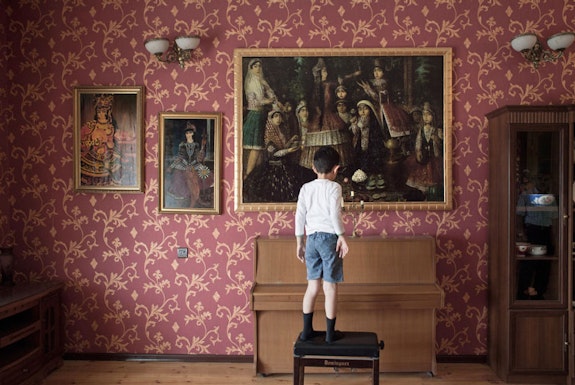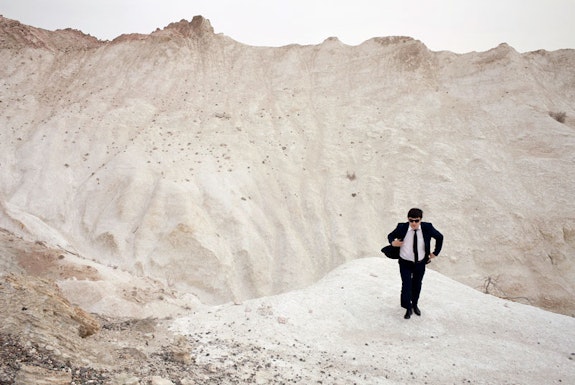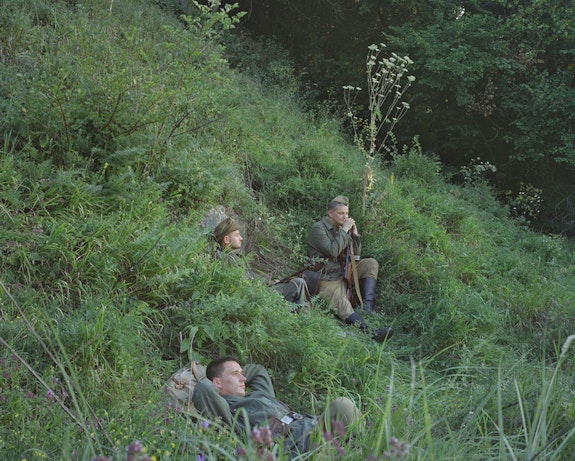ArtSeen
Imagined Communities: Photographs by Mila Teshaieva
Cambridge, MA
MIT MuseumAugust 2, 2018 - February 28, 2019
Though her first East Coast solo exhibition is formally promoted as featuring three of her recent photographic series that explore the complexities of national identities and memories in former USSR territories, the brilliance of photographer Mila Teshaieva's show lies not in the expansive and consciously composed photographs alone but in their total installation. By borrowing a few choice didactic practices of historical museums, the presentation of her works deliberately and effectively blurs the boundary between fact and fiction—in other words, at the location where memory lives.
An impressive golden wall bearing the show's title, Imagined Communities, and introductory text welcomes the visitor at the entrance. On the adjacent wall a small, nondescript map of countries in the Caspian region in Central Asia, the Balkans, and Ukraine further orients the visitor to the places that will be discussed, adding to the show's objective pretext. An enlarged version of one of Teshaieva's photographs—placed next to the generic map—shows a boy standing with his back turned to the audience, transfixed by a painted group portrait of exotically dressed Iranian women. Its promise to entice ushers the visitor into Teshaieva's probing odyssey of the national and historical imaginary.
Instead of the conventional labels providing the title and pertinent information of the artworks, each photograph in Imagined Communities is accompanied by a lengthy caption printed on the wall explaining in earnest the subject of each image. However, the text's didactic, political explanation of the image is often unclear or bizarre, which is typically how didactics function in state historical museums, leaving the viewer to question the intention of the text, the image, or both.
The captions attempt to narrate the meaning of the images to absurd and sometimes comical effect. In one example, a hapless man wearing a dark suit and sunglasses is standing in front of a white, barren mountain range. The caption describes this person as a confused driver who cannot read the signs, which the new government in Turkmenistan has recently changed from Cyrillic to Latin. The caption wryly notes in its conclusion, "For now, he relies on intuition to find his direction." This photo is part of the first photographic series, "Promising Waters," of the three presented in the exhibition. Detailing how ordinary people in Azerbaijan, Kazakhstan, and Turkmenistan—like the driver—are adapting to the new social and national realities of independence after Soviet rule, "Promising Waters" presents national identity and memory in a state of transition.
"Sorry, Not Sorry," the show's second photographic series, moves west to the contemporary Balkan countries and considers memory and identity as created through national historical sites. One photograph in this series apparently captures the commemoration ceremony of the 1389 Battle of Kosovo, an important battle which was also used politically to justify six centuries later the Serbian territorial wars in the 1990s. Yet the image merely portrays a desolate landscape with a few obscure figures in the background. The entire image surface is so purposefully covered by a gray film of mist that it becomes hard to imagine that a pivotal battle once occurred here, let alone a commemoration ceremony in the present day. The refusal of Teshaieva in "Sorry, Not Sorry" to focus on the grand narratives of the past, as well as their service to group interests in the present, creates an uncanny space for a third narrative of these sites to emerge, one that stands apart from national memory and its historical mobilization.
For her third series, "Unfamiliar Memories," Teshaieva invited individuals in Ukraine to reenact memories from their grandparents' generation during WWII and the subsequent Soviet era. The accompanying captions of each photograph are quotes from these individuals reflecting on the particular memory that they chose to reenact for Teshaieva's camera. It is a powerful body of work that explores historical and national memory as the construct of personal narratives rather than collectively produced visions.
But like in the images in "Promising Waters" and "Sorry, Not Sorry," in "Unfamiliar Memory" historical fact and fantasy mutually fill in the gaps of each other. A work in "Unfamiliar Memory" quotes a participant who says he and his family were never able to know his grandparents, who served in the military. The corresponding picture is of an idyllic scene of three men in military uniforms resting in the grass. It is unclear whose memory they are performing for the camera though—their own memory of their grandparents, the unknowable memory of their grandparents during wartime, or the memory of their grandparents reconciled with the more familiar national memory of the war.
Returning to the entrance to exit the show, we catch a glimpse again of the boy gazing at the painted group portrait. Its caption reveals that the boy is falsely informed that those portrayed are his ancestors. From a young age, memory and identity is learned through such images and words. And they are inescapable even once one realizes that the images and words are imagined too.




